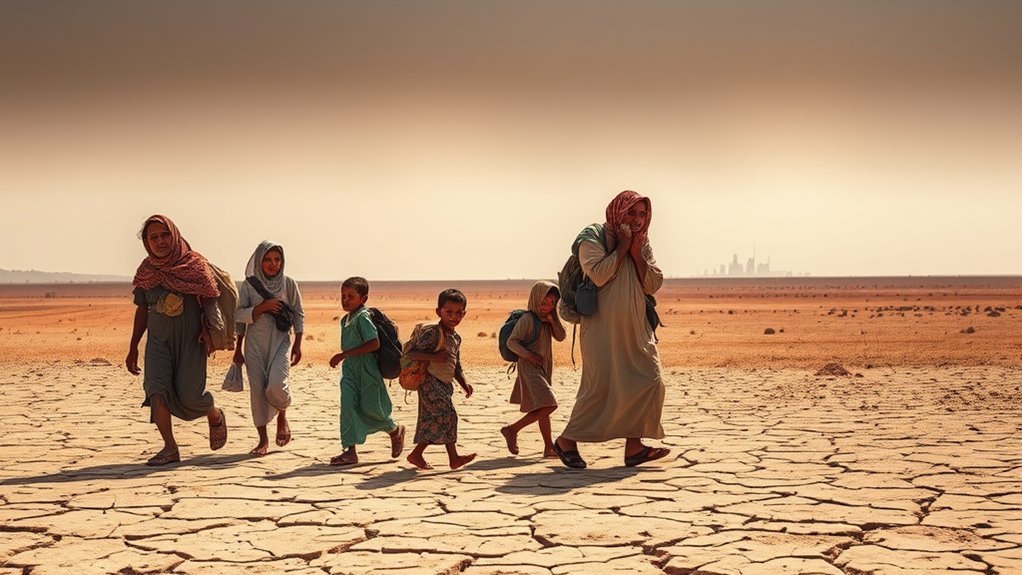By 2025, climate change continues to drive migration as rising sea levels, extreme weather, and environmental deterioration force millions from their homes. Coastal areas become unlivable, prompting displacement and the need for urgent resettlement policies. Adaptation strategies like resilient infrastructure and international cooperation are vital to manage these shifts. If you want to understand how governments and communities are tackling this crisis and what solutions are emerging, there’s more to explore.
Key Takeaways
- Rising sea levels and extreme weather events are displacing populations from coastal and vulnerable regions globally.
- Governments are implementing policies for immediate aid and long-term resettlement of climate-induced migrants.
- Investment in resilient infrastructure and sustainable agriculture reduces future displacement risks.
- International cooperation and funding support adaptation projects and legal recognition of climate refugees.
- Building resilient communities and safe migration pathways are essential for managing climate-driven migration in 2025.

As climate change accelerates, more people are being forced to leave their homes due to rising sea levels, extreme weather events, and deteriorating living conditions. This growing crisis leads to climate refugees—individuals displaced by environmental factors beyond their control. Governments and organizations worldwide recognize that addressing this challenge requires effective displacement policies and adaptation strategies. You might wonder how nations are managing this influx of displaced populations. Some are developing thorough displacement policies that not only provide immediate aid but also outline long-term resettlement plans. These policies aim to protect vulnerable communities, ensuring they receive support during and after their migration. Many governments are also integrating adaptation strategies into their climate action plans. These strategies include investing in resilient infrastructure, such as flood defenses and drought-resistant agriculture, to reduce future displacement risks. By proactively strengthening communities, nations hope to minimize the need for forced migration in the first place. As climate impacts worsen, the importance of flexible and inclusive displacement policies becomes even more apparent. You’ll see some countries creating legal frameworks to recognize climate-induced displacement, granting refugees rights and access to resources. These policies help prevent chaos and exploitation while promoting orderly migration. Meanwhile, adaptation strategies focus on building resilience within vulnerable regions, allowing communities to withstand environmental stresses and stay in their homes. These measures not only protect lives but also preserve cultural and economic ties that define communities. When displacement becomes unavoidable, effective policies facilitate safe relocation, ensuring that displaced individuals don’t fall into poverty or face discrimination. You might also notice that international cooperation plays an essential role. Countries are working together to develop shared frameworks for managing climate refugees, recognizing that climate change knows no borders. Funding from global organizations supports local adaptation projects and the development of displacement policies. Ultimately, addressing climate-induced migration requires a combination of these approaches. You need policies that manage displacement humanely and strategies that reduce the need for migration altogether. It’s about creating resilient communities capable of withstanding environmental challenges and providing safe pathways for those forced to move. As climate change continues to reshape the world, your awareness of these policies and strategies becomes indispensable. They’re not just abstract concepts but critical tools to protect lives, uphold dignity, and build a sustainable future amid an increasingly unstable climate. Implementing reliable backup power solutions is one way communities can increase resilience against climate-related disruptions.
Frequently Asked Questions
How Do Climate Refugees Access Legal Protection?
You can access legal protection as a climate refugee through legal recognition and protection frameworks, though these are often limited. You need to apply for asylum or refugee status in a host country, demonstrating climate change impacts. Some international organizations advocate for dedicated protections, but many countries lack specific policies. Staying informed about your rights and seeking legal assistance can improve your chances of gaining the necessary legal recognition and protection.
What Are the Economic Impacts of Climate-Driven Migration?
You’ll see economic impacts as climate-driven migration challenges your local labor market and tests economic resilience. As migrants seek safety, they may fill labor shortages or, conversely, increase competition for resources. This shifts economic stability, prompting communities to adapt. While some regions benefit from new skills, others face strain. Overall, these migrations reshape economies, highlighting the need for resilient policies to support both migrants and host communities effectively.
How Are Host Countries Managing Increasing Refugee Populations?
You’ll notice host countries are actively managing rising refugee populations through focused urban planning and cultural integration efforts. Curiously, over 60% of cities hosting climate refugees are investing in inclusive infrastructure to support newcomers. They prioritize cultural integration programs, language classes, and community events, fostering cohesion. These strategies help minimize social tensions and ensure that both refugees and local populations adapt smoothly, creating resilient, welcoming environments for all.
What Role Do International Organizations Play in Climate Refugee Crises?
International organizations play a vital role in climate refugee crises by providing international aid and facilitating policy coordination. They support affected countries with resources, expertise, and frameworks to manage migration and adaptation efforts. You can rely on these organizations to help develop all-encompassing policies, guarantee humanitarian aid reaches displaced populations, and promote global cooperation, ultimately easing the burden on host nations and protecting vulnerable climate refugees.
How Does Climate Change Influence Long-Term Migration Patterns?
Climate change markedly influences long-term migration patterns by causing environmental displacement, prompting you to seek safer areas. As environmental conditions worsen, you might need to adapt culturally to new communities, which can be challenging but essential for integration. These shifts reshape migration trends over decades, making environmental displacement a key factor. You’ll find that cultural adaptation becomes a critical part of establishing stability in new regions affected by climate change.
Conclusion
As you witness the rising tide of climate refugees, remember that their journeys are like fragile leaves caught in a relentless storm. Climate change isn’t just shifting borders; it’s rewriting lives and futures. You hold the power to be part of the solution, helping to calm the storm or at least slow its fury. Together, we can turn the tide and nurture a world where no one has to become a refugee simply because the Earth is crying out for help.









